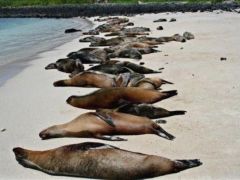By Jordan Greene - The Santiago Times
The bodies of sea lions, cormorants and penguins were
discovered on Sunday littering a seven mile stretch of beach in Punta de
Choros, northern Chile, is the proximity of the Humboldt Penguin Nature
Reserve. Fisheries officials and police are investigating since there
are serious suspicions that the deaths were caused by local fishermen
using explosives to increase catches.
Two days prior the Movement in Defence of the Environment (MODEMA) reported a group of ten fishing boats off the coastline of Punta de Choros, which apparently were sighted using explosives.
Sernapesca, Chile’s National Fishing Service, investigated the scene and determined that all the animals were killed by the same incident. Autopsies report animals with fractured skulls, missing rib cages and multiple abrasions.
Local authorities promptly called in the Investigative Police’s (PDI) Environmental Crime Brigade for further investigation. Microbiological and chemical analysis tests are currently being run to determine if blast fishing is the cause of death.
In Chile, blast fishing is illegal. Companies caught fishing in this manner face prison time and fines. The monetary amount depends on the damage to the ecosystem. However, causing the death of penguins during commercial activities is a offence which can end perpetrators in prison.
Officials from Sernapesca told The Santiago Times that the combined offences amount to a “serious crime.”
“This situation is quite complicated because of the crime scene’s location near the penguin reserve,” Cristián Felmer, an environmental expert, stated to the press. ”This is one of the most important environmental incidents we’ve had in recent memory.”
This isn’t the first environmental calamity at Punta de Choros. In April of last year, 350 Guayano cormorants washed up on the beach. The next month, Sernapesca reported the deaths of more than 80 sea lions.
In light of the most recent crime, the international marine conservation group Oceana is pushing to have Punta de Choros made a Marine and Coastal Protected Area (AMCP). The proposal would limit human activity along the more than 175-mile coastline to eco-friendly tourism.
”While there are two marine reserves in the area, this ecosystem is much larger and has little protection from threats such as those that apparently killed all these birds,” Alex Muñoz, executive director of Oceana, told the media.
Oceana filed a joint proposal with scientists from Universidad Católica and the Centre for Advanced Studies in Dry Areas (CEAZA) to make Punta de Choros a AMCP in 2010. The proposal came amid plans to build a thermoelectric power plant in the area. The highly controversial plan was scrapped after generating a wave of protests.
Punta de Choros is a small fishing village of 320 people. It is also home to the largest population of Humboldt penguins in the world. The site attracts thousands of tourists annually.
source



















No comments:
Post a Comment